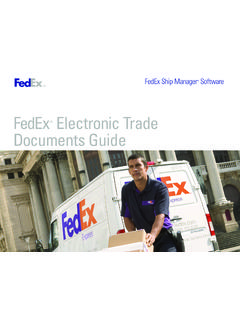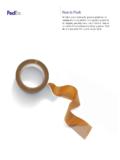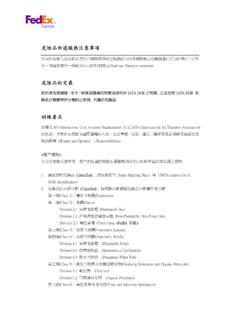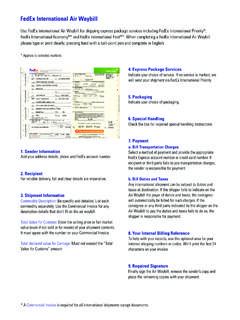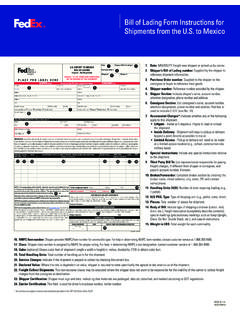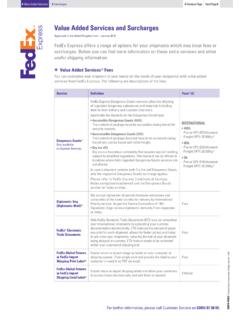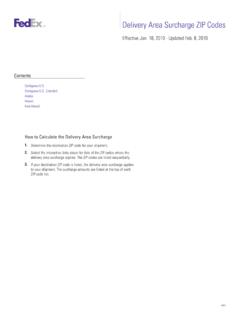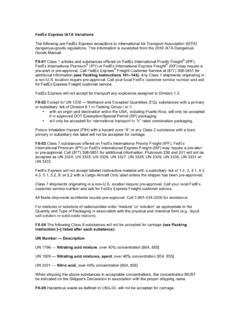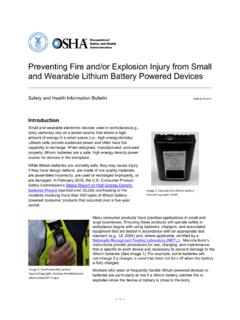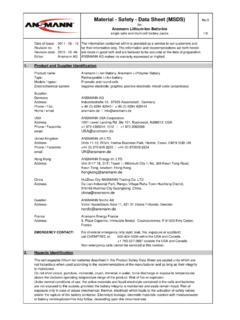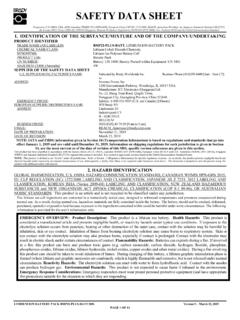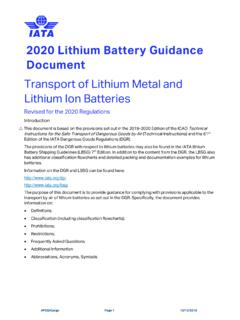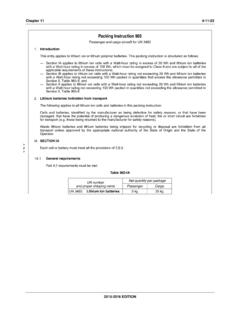Transcription of Lithium Battery Shipping Overview - FedEx
1 Lithium Battery Shipping Overview (also see )PGH safety April 2019 Lithium batteries are used in many electronic devices such as cameras, cell phones, laptop computers, medical equipment and power tools. When Shipping or importing Lithium batteries, including those contained in or packed with devices and equipment, packaging requirements must be met and package contents must be declared to transportation companies and the Postal Service/SmartPost. Cause for Concern While most Lithium batteries are safe, some have overheated and caught fire. Once ignited, they can cause any nearby batteries to overheat and catch fire.
2 These fires can be difficult to put out and produce toxic and irritating fumes. Identify the presence of Lithium batteries inside of a package. When Shipping Lithium batteries, it is not always clear which mode of transport will be used. Shipments may end up on an aircraft and an aircraft s fire suppression system may not be able to extinguish all types of Lithium Battery fires. Counterfeit/fake and no-brand Lithium batteries are also of concern because they may not have been safety -tested. These Lithium batteries may be poorly designed, have little protection, and/or contain manufacturing flaws. It is important to verify the batteries planned for shipment have been safety -tested.
3 A Lithium Battery test summary (TS) document should be requested before any Battery is & TrainingRegulations differ when Shipping by air (this includes FedEx Ground shipments to Alaska and Hawaii), water or USPS/SmartPost service. FedEx Ground strongly recommends that anyone Shipping Lithium batteries take a specific Lithium Battery Shipping class in order to better understand these complex regulations and meet DOT/ICAO/IATA/IMDG/USPS requirements. FedEx Ground offers an economical Lithium Battery Shipping on-line course to help you meet this requirement for ground Shipping . Please contact the Dangerous Goods hotline at 800-GOFEDEX, Option 81 for more information on this course.
4 Please consult the most recent version of the Department of Transportation (DOT) regulations for Shipping Lithium batteries found in for the most updated information. Basic transport requirements Critical: Passing of safety tests for Lithium batteries and cells (Refer to the UN Manual of Tests and Criteria- UN/DOT ). This will be indicated in the test summary document requested from your supplier. There are recordkeeping requirements for this testing which can be found in Use of separate proper Shipping names for Lithium ion batteries and Lithium metal batteries: Lithium -ion batteries: UN3480 Lithium -ion batteries packed with or contained in equipment: UN3481 Lithium metal batteries: UN3090 Lithium metal batteries packed with or contained in equipment.
5 UN3091 Only allow small and medium-sized Lithium cells (<60 watt-hours for ion or <5 grams for metal) and batteries (<300watt-hours for ion or <25 grams for metal) to be shipped as partially regulated in the 48 contiguous states by highwayor rail if stricter packaging and marking requirements are met (please see flowcharts at the end of the document). In addition to the markings listed in the markingrequirements section on page three, packages of medium-sized Lithium batteries ( Lithium Ion: >100 watt hours and<300 Watt hours OR Lithium Metal: >2 grams andLithium Battery Shipping Overview PGH safety April 2019 <25 grams) must be additionally marked with the following statement: Lithium BATTERIES FORBIDDEN FOR TRANSPORT ABOARD AIRCRAFT AND VESSEL.
6 Certain types of Battery shipments are prohibited or may require special arrangements in the FedExGround network. Contact the PGH safety Department if someone wants to ship any of the followingoDamaged, defective or recalled batteriesoBatteries for disposal or recycling Batteries that have not passed safety testing, Low-production and prototype batteries have specificrequirements for Shipping which are detailed in the section of the regulations. Lithium batteries are regulated based on the rated watt-hours for Lithium ion batteries or the weight of thelithium contained in the batteries for Lithium metal batteries.
7 This information is usually marked on thebattery or documented on a safety Data Sheet (M/SDS) which can be obtained from your supplier or thebattery and medium sized Lithium Ion Battery exceptions This section applies to the transport of small Lithium ion (<20 watt hours for cells/<100 watt hours forbatteries) and small Lithium metal (<1 grams for Lithium metal cells/<2 grams for Lithium metal batteries) andmedium Lithium cells and batteries (60-300 watt-hours for Lithium ion and >2 grams and <25 grams for lithiummetal). This also covers cells and batteries packed with, or contained in, equipment. Cells and batteries must be packaged in accordance with the requirements listed in 49 CFR , UN specification packaging (POP) is encouraged but not required.
8 The batteries must be placed in inner packaging designed to prevent damage, short circuits and movement withinthe outer package. The Battery terminals are of a particular concern. They should not be able to contact otherbatteries and/or any other conductive contents or packaging. The batteries must be placed in rigid outer packaging. If the shipper chooses to use soft outer packaging, such asa padded envelope with the rigid packaging inside, the outer packaging must be marked as an OVERPACK . Ifthe Battery is contained (installed) in a device, the rigid packaging may not be necessary provided that the devicewill offer at least the same protection as rigid packaging.
9 If the Battery is contained in a device, there needs to be a positive means to prevent activation of the device duringtransportation. This may be accomplished by measures such as disconnecting the Battery or placing tape over aswitch The package must not exceed 30 kg (66 lbs.) gross weight. This weight limit does not apply to Lithium cells orbatteries packed with or contained in Battery Shipping Overview PGH safety April 2019 Marking Requirements: Except for a package containing button cell batteries installed in equipment (includingcircuit boards), or no more than four Lithium cells or two Lithium batteries installed in a device, the outer packagemust display a Lithium Battery handling mark.
10 The handling mark for Lithium batteries installed in or packed withequipment is displayed below. The new version of the handling mark must include the appropriate UN Identification number (seeBasic Transport requirements above) as well as a phone number for additional information aboutthe shipment. This number does not need to be an emergency response phone number, nor does itneed to be a phone number. The packages must be of a sufficient size that the marking willcompletely fit on one package surface, when packages are required to bear this Test: Except when cells or batteries are contained in equipment, each package must be capable of withstanding a m drop test in any orientation without damage to the cells or batteries contained in the package, without shifting of the contents that would allow short-circuiting, and without release of package contents.
